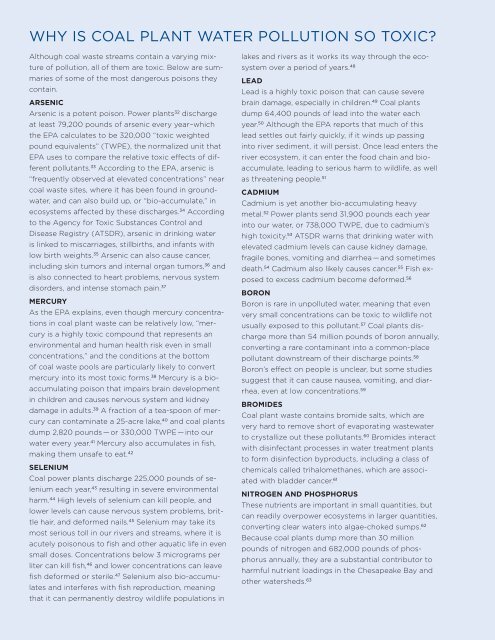of cleaning up its pollution, rather than freely dumpingit into rivers. The common-sense treatments requiredby the EPA’s proposed rules are remarkably affordable,amounting to substantially less than one percentof revenue for almost all coal plants, and no more thantwo pennies a day in expenses for ordinary Americans,if utilities passed costs onto consumers in their electricitybills. 22 In exchange for two cents a day, we couldend most toxic water pollution in this country.The EPA must finalize a zero discharge rule and put uson a path to solving one of our most widespread andharmful pollution problems. It is time to move forwardand protect public health and environment.1. <strong>THE</strong> TOXIC LEGACY OF COAL PLANTWATER POLLUTIONThe 5.5 billion pounds of water pollution from coalpower plants every year include at least 1.79 billionpounds of metals, including arsenic, selenium, cadmium,chromium, and mercury. 23 These toxics are hazardousto humans or aquatic life in very small doses (measuredin parts per billion) because they do not degradeover time and bio-accumulate, meaning they increasein concentration as they are passed up the food chain.Much of the remaining pollution consists of “nutrients”such as nitrogen and phosphorus, which contribute tothick, soupy algal blooms that can choke watersheds,such as the Chesapeake Bay. 24This dumping occurs in astonishing volumes. The EPAestimates that, each year, up to 14.5 billion gallons of flyash transport water and up to 6.6 billion gallons of bottomash transport water may be produced at just onepower plant and dumped into ash ponds. 25 Making waterpollution worse, many plants either have installed,or will soon install, smokestack “scrubbers” — systemsthat can prevent toxic metals from going up thesmokestack into the air. The problem is that scrubbersoften concentrate the metals they remove into a wet,toxic, sludge that generally does not undergo anyeffective treatment. 26 Thanks to stricter air pollutionrules, scrubber use has increased by 900 percent since1982. 27 Yet, there are no standards to ensure protectivewastewater treatment of the scrubber sludge, and sothis especially toxic new wastewater stream is endingup in settling ponds where it then makes its way intorivers, streams, and lakes.And that’s not all: Toxic pollution also occurs whenleachate systems for landfills and ash impoundmentsdischarge untreated or inadequately treated wastewaters.28 In some cases, coal ash landfills or pondscover hundreds of acres, fill in local wetlands, and turnstreams into drainage ditches for waste that either leakor discharge from these sites. 29 Many of these wastedumps or ponds have no liners to prevent pollutionfrom leaking out of them. 30According to the EPA, tens of thousands of miles ofrivers are degraded by this pollution. 31 The EPA hasalready identified 132 separate cases where a powerplant contaminated surface waters and another 123cases where groundwater was damaged. With respectto arsenic, boron, cadmium, iron, lead, manganese,nickel, selenium, and thallium, the 290 coal plantssurveyed by EPA put as much of a burden on theenvironment as thousands of sewage plants.In addition to those listed opposite, the EPA has identifiedmany other dangerous substances in coal plantwastewater, including chromium, molybdenum, andthallium. 64 In almost every instance, coal plants arethe largest source of each of these water pollutantsnationally.The EPA calculates that the annual pollution from coalpower plants translates into more than eight millionTWPE or toxic weighted pound equivalents, indicatinga huge toxic burden on the nation’s waters. 65 Thatfigure dwarfs the pollution from any other industrialcategory in the United States and is more than theother top nine polluting industries combined — morethan all the paper mills in the country, more than all therefineries, more than all the chemical plants and fertilizerfacilities and ore mills and incinerators. 66 The wasteis also far more toxic than any discharge from a typicalpublicly-owned treatment works, the sort of sewageplant that serves cities and towns. Scrubber wastealone contains 80 times more selenium than a typicalsewage plant’s waste. 67 With respect to toxic pollution,the 290 coal plants surveyed by EPA put as much ofa burden on the environment as thousands of sewageplants. 68 With hundreds of coal power plants acrossthe country, it is no surprise that coal plant pollutionposes such a serious threat to our waterways.HOW COAL PLANT WATER POLLUTION AFFECTS USCoal power plants can use millions of gallons of waterevery day, so most power plants sit on or near a waterbody. This means that coal plants discharge into hundredsof rivers, lakes, and streams all across the UnitedStates. These waters are often popular recreationalspots for boating, swimming, and fishing and are drinkingwater sources for nearby communities. Fishingprovides an inexpensive, reliable, and healthy foodsource, but when fish are contaminated, communitiesthat depend on fishing are far more vulnerable thanthe general population.There is no question that harm to fish and otherwildlife from coal waste discharges is widespread and4 Closing the Floodgates
WHY IS COAL PLANT WATER POLLUTION SO TOXIC?Although coal waste streams contain a varying mixtureof pollution, all of them are toxic. Below are summariesof some of the most dangerous poisons theycontain.ARSENICArsenic is a potent poison. Power plants 32 dischargeat least 79,200 pounds of arsenic every year–whichthe EPA calculates to be 320,000 “toxic weightedpound equivalents” (TWPE), the normalized unit thatEPA uses to compare the relative toxic effects of differentpollutants. 33 According to the EPA, arsenic is“frequently observed at elevated concentrations” nearcoal waste sites, where it has been found in groundwater,and can also build up, or “bio-accumulate,” inecosystems affected by these discharges. 34 Accordingto the Agency for Toxic Substances Control andDisease Registry (ATSDR), arsenic in drinking wateris linked to miscarriages, stillbirths, and infants withlow birth weights. 35 Arsenic can also cause cancer,including skin tumors and internal organ tumors, 36 andis also connected to heart problems, nervous systemdisorders, and intense stomach pain. 37MERCURYAs the EPA explains, even though mercury concentrationsin coal plant waste can be relatively low, “mercuryis a highly toxic compound that represents anenvironmental and human health risk even in smallconcentrations,” and the conditions at the bottomof coal waste pools are particularly likely to convertmercury into its most toxic forms. 38 Mercury is a bioaccumulatingpoison that impairs brain developmentin children and causes nervous system and kidneydamage in adults. 39 A fraction of a tea-spoon of mercurycan contaminate a 25-acre lake, 40 and coal plantsdump 2,820 pounds — or 330,000 TWPE — into ourwater every year. 41 Mercury also accumulates in fish,making them unsafe to eat. 42SELENIUMCoal power plants discharge 225,000 pounds of seleniumeach year, 43 resulting in severe environmentalharm. 44 High levels of selenium can kill people, andlower levels can cause nervous system problems, brittlehair, and deformed nails. 45 Selenium may take itsmost serious toll in our rivers and streams, where it isacutely poisonous to fish and other aquatic life in evensmall doses. Concentrations below 3 micrograms perliter can kill fish, 46 and lower concentrations can leavefish deformed or sterile. 47 Selenium also bio-accumulatesand interferes with fish reproduction, meaningthat it can permanently destroy wildlife populations inlakes and rivers as it works its way through the ecosystemover a period of years. 48LEADLead is a highly toxic poison that can cause severebrain damage, especially in children. 49 Coal plantsdump 64,400 pounds of lead into the water eachyear. 50 Although the EPA reports that much of thislead settles out fairly quickly, if it winds up passinginto river sediment, it will persist. Once lead enters theriver ecosystem, it can enter the food chain and bioaccumulate,leading to serious harm to wildlife, as wellas threatening people. 51CADMIUMCadmium is yet another bio-accumulating heavymetal. 52 Power plants send 31,900 pounds each yearinto our water, or 738,000 TWPE, due to cadmium’shigh toxicity. 53 ATSDR warns that drinking water withelevated cadmium levels can cause kidney damage,fragile bones, vomiting and diarrhea — and sometimesdeath. 54 Cadmium also likely causes cancer. 55 Fish exposedto excess cadmium become deformed. 56BORONBoron is rare in unpolluted water, meaning that evenvery small concentrations can be toxic to wildlife notusually exposed to this pollutant. 57 Coal plants dischargemore than 54 million pounds of boron annually,converting a rare contaminant into a common-placepollutant downstream of their discharge points. 58Boron’s effect on people is unclear, but some studiessuggest that it can cause nausea, vomiting, and diarrhea,even at low concentrations. 59BROMIDESCoal plant waste contains bromide salts, which arevery hard to remove short of evaporating wastewaterto crystallize out these pollutants. 60 Bromides interactwith disinfectant processes in water treatment plantsto form disinfection byproducts, including a class ofchemicals called trihalomethanes, which are associatedwith bladder cancer. 61NITROGEN AND PHOSPHORUSThese nutrients are important in small quantities, butcan readily overpower ecosystems in larger quantities,converting clear waters into algae-choked sumps. 62Because coal plants dump more than 30 millionpounds of nitrogen and 682,000 pounds of phosphorusannually, they are a substantial contributor toharmful nutrient loadings in the Chesapeake Bay andother watersheds. 63Closing the Floodgates5



